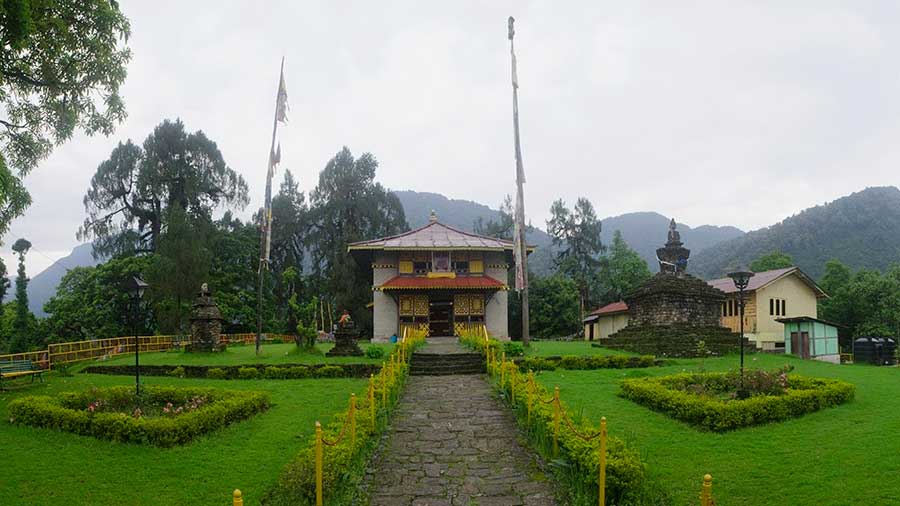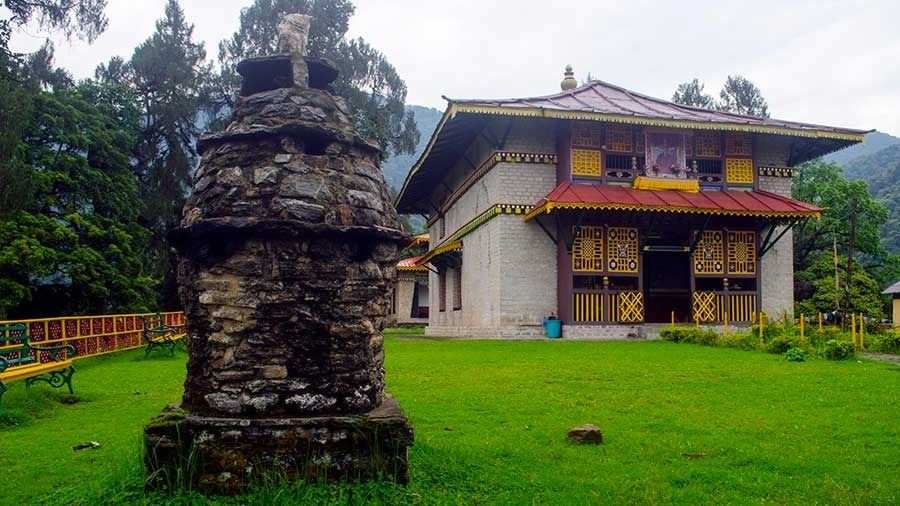Yuksom, a small village in the northwestern corner of Sikkim, is well known as the starting point of the famous Dzongri-Goecha La trek. When you arrive here, you will be flocked by agents offering many deals on treks. However, this picturesque destination, about six hours from Gangtok, has much more to offer — including a rich history dating back centuries.
Storied history
Sikkim was once known as Denjong, meaning ‘the valley of rice’. Buddhism was introduced to the region as early as the 8th or 9th centuries. The most tumultuous time in Yuksom’s history was during the power conflict between the ‘Yellow Hats’ and the ‘Red Hats’ sects in Tibet.
One of the prime lamas of what is referred to as Indo-Tibetan Buddhism made his way southwards from Tibet. Lutsum Chembo, part of the Nyingma sect, had set out with the mission of establishing a Buddhist monarchy in the hidden country of Denjong.

The stone throne on which the first king of Sikkim was crowned can still be seen Rangan Datta
After a long journey, he reached a place called Norbugang in 1641. There, he met two other lamas, Sempa Chembo and Rinzing Chembo. The three holy men started searching for a monarch to rule the land. They found the right candidate in the great grandson of the legendary Sikkimese hero Guru Tashi — Phunstok. From near present-day Gangtok, he was rushed to Norbugang.
There, on a stone throne, the three Lamas crowned him the King of Sikkim. He was given the title of Chogyal, meaning the king who rules with righteousness, and was conferred the surname Namgyal. The place was renamed Yuksum (or Yuksom), meaning the meeting place of the three superior ones. The stone throne on which the coronation took place can still be seen and is known as the Throne of Norbugang.

A street in Yuksom Rangan Datta
Although of huge historic importance, the throne is basically a simple throne platform lying in the shadows of a gigantic pine tree, which dates back to the time of the coronation.
The stone throne has four seats at different levels. The top one was meant for Lama Lutsum Chembo, the slightly lower one on his right was for Phunstok and the two lower seats on the left were for the other two lamas.
In front of the throne, a large stone has a footprint of Lutsum Chembo. Just opposite the throne is a chorten (stupa), which is said to contain water and soil from all over Sikkim. The complex also houses a new monastery and is beautifully landscaped with paved walking trails. Fluttering coloured prayer flags welcome visitors to the Archaeological Survey of India (ASI) site.

Dubdi Monastery is built atop a hill commanding a bird’s eye view of Yuksom Rangan Datta
Just outside the complex is a small pond called Kothak Pokhri. The pond dates back to the time of the coronation and the newly crowned king was blessed with water from this pond. Even today, the Sikkimese consider the pond to be holy and is decorated with colourful prayer flags.
More than half a century after the coronation, a monastery was built atop a nearby hill commanding a bird’s eye view of the sleepy town of Yuksom. Known as the Dubdi Monastery, it was built in 1701 and is an ASI-protected site. An hour’s trek from the town leads to the monastery. The trail is well marked and slopes gently upwards.
Sadly, the monastery remains closed most of the time. But the complex has several other structures and stupas of interest.
Travel details
- Yuksom is about six hours from Siliguri
- There are plenty hotels and homestays available in Yuksom
- A trip to Yuksom can be combined with the popular tourist destination of Pelling, 33 km away
Rangan Datta is a mathematics and management teacher by profession and a travel writer and photographer by passion. He has been addicted to discovering off-beat places since his undergraduate days at St. Xavier's College. Blogging and contributing to Wikipedia are his other passions.
